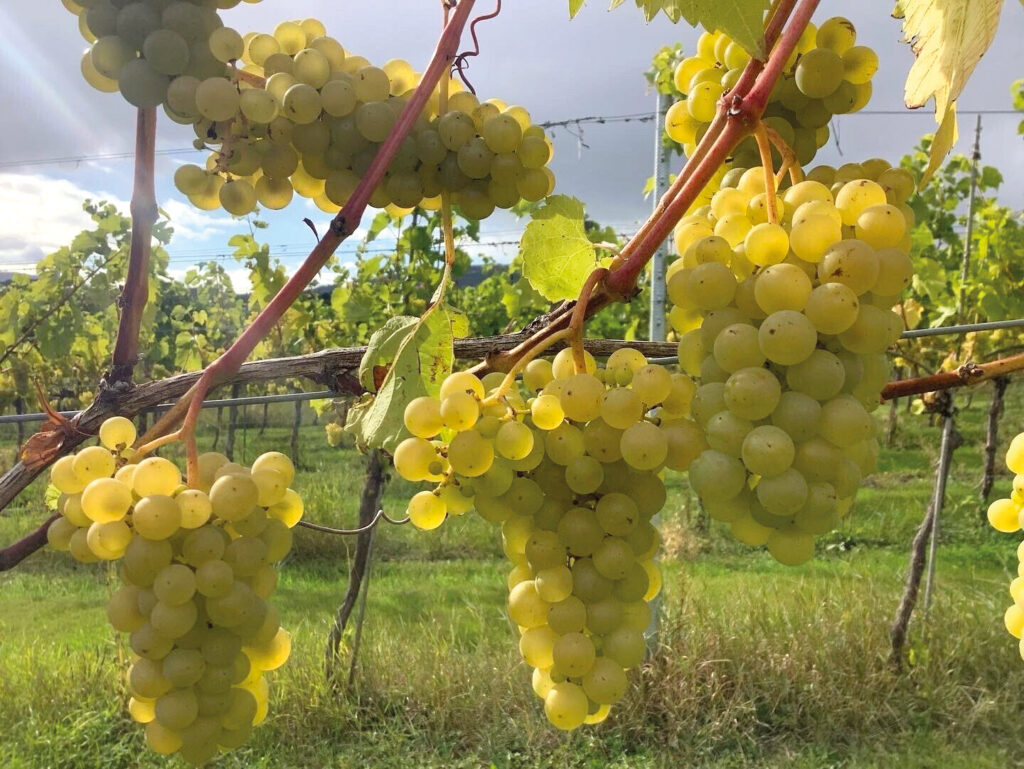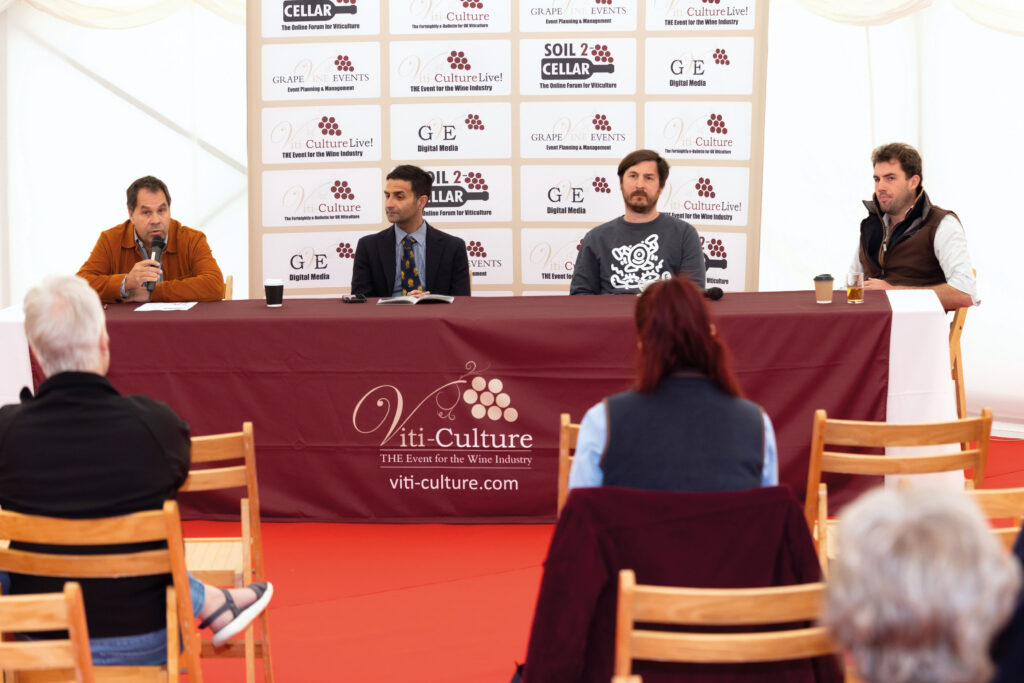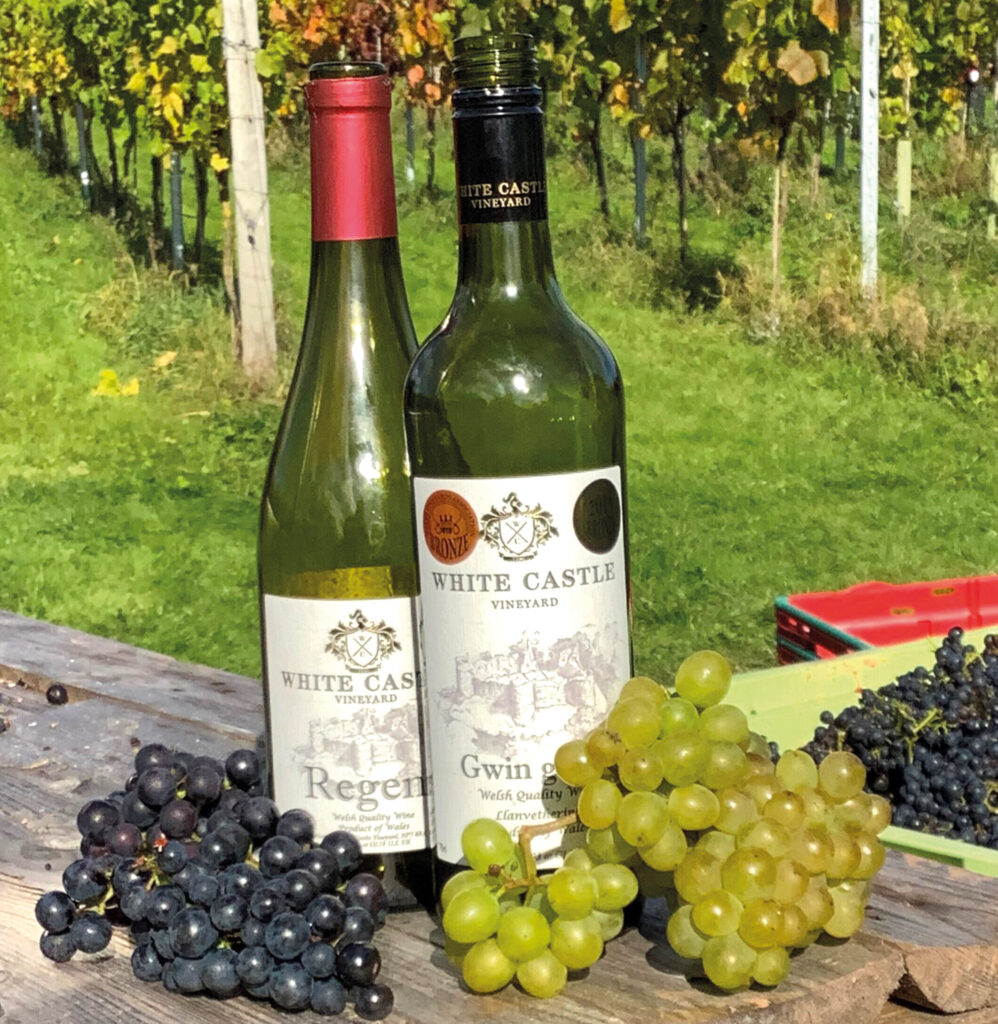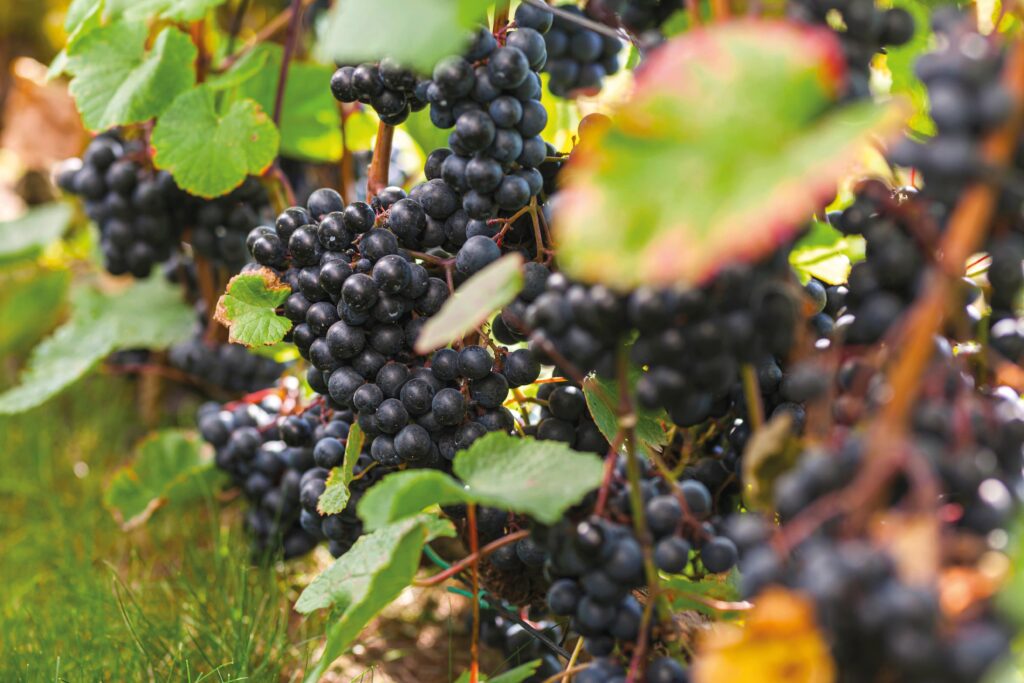The pros and cons of growing piwi varieties
26th September 2023
Can piwi varieties help British vineyards manage the threat of disease? What do growers need to do differently when managing these hybrid varieties? Do they make good wine – and how do we market them to consumers? The Viti-Culture event in East Sussex saw a panel of experts tackle these questions.

Robb and Nicola Merchant, of White Castle Vineyard attended the seminar and shared their experiences growing piwis. Pictured here are Phoenix grapes growing at their vineyard in Abergavenny.
As British vine growers look with increasing interest to hybrid varieties that offer fungal resistance, there are several questions about the opportunities and challenges they present. Visitors at the Viti-Culture event heard from Ben Brown, viticulture agronomist at Agrii; Sergio Verrillo, winemaker at Blackbook Winery; and Dr Greg Dunn, head of the wine division at Plumpton College.
Piwis, a mix of Vitis vinifera and North American grape varieties bred for resistance to fungal disease, are becoming increasingly important to many wine growing regions around the world. One of the most passionate advocates of piwis, Sam Doncaster, who works with Freytags Nursery in Germany, said it is becoming difficult to keep up with demand for these varieties – and not just from alternative vineyards, but traditional growers too.
Pros and cons
Although the number of sprays per year depends on the variety, Ben Brown, who has designed a number of programmes for piwis now, recommends around 4-6. Robb Merchant, of White Castle Vineyard in Abergavenny, who was in the audience during the debate, said this fits with his experience as a piwi grower.
Piwis offer three key opportunities for British growers, according to Greg Dunn:
- The opportunity to use less pesticides, with obvious economic and sustainability benefits
- The ability to reliably ripen profitable yields. This is a real threat to the UK wine industry and much of this ability is limited by disease
- Spraying less means fewer tractor passes, which not only reduces emissions but also protects soil from structural decline and compaction.
Piwis could also offer opportunities for organic growers, Greg suggested, as recent research has shown that downy mildew – a particular challenge for organic vineyards – is one of the key reasons organic is less productive than conventional.
Challenges, on the other hand, include maintaining the fungal resistance, potential issues with wine making, lack of funding for research, and marketing and consumer perceptions. There are also unknowns such as whether we can spur prune piwis – and if we can and we’re making still wine, there is an opportunity for mechanisation which will significantly reduce the cost of production, Greg added.

(l-r): Greg Dunn, head of Plumpton College’s wine division; Chets Modi, NFU Mutual; Sergio Verrillo, winemaker at Blackbook Winery; and Ben Brown, viticulture agronomist at Agrii
Managing piwis in the UK
Fungal resistance is not an absolute and it’s not forever. Maintaining the disease resistance of piwi varieties is a key issue as breeding a new grape variety is a 25–30-year process – compared to 7–8 years for a new wheat variety for example, Ben explained. Maintaining disease resistance is therefore something we need to consider when planning fungicide programmes.
A common misconception regarding piwis is their tolerance to all diseases; depending on the variety there may be loopholes for black rot and anthracnose, Ben added. While these are generally less of an issue now, especially with conventional spray programmes, they can cause a high level of crop and yield loss – so this is something to think about where resistance hasn’t been bred into these hybrids. The main concern would be early season black rot up to veraison, Ben continued, recommending 3–4 sprays depending on rain pressure. Piwi varieties are generally bred to have loose clusters so they’re more disease tolerant for botrytis, however any wounds can sit and colonise, so a couple of late season botrytis sprays may also be needed.
Generally, however, piwis have moved from monogenic resistance – offering single gene resistance – to predominantly two genes that convey resistance to fungal diseases. With botrytis, rather than the genetic disease resistance seen with powdery mildew and downy mildew, it is more of a physiological or phenological resistance, Ben explained.
Another big issue is that piwis seem to have a lot more vigour. “With Voltis in particular, there has been some work suggesting that essentially the first two buds are like Chardonnay, so it is not very fruitful on the first two buds.”
The increased vigour should not directly impact nutritional requirements, although growers might cut out a bit of nitrogen application. However, piwis “definitely seem to suffer more from magnesium deficiency and sometimes potash” – which is likely down to the American varieties having a greater requirement or being less adapted to utilising it.
Robb Merchant – who grows several piwi varieties including Regent, Rondo, Phoenix, Pinot Noir Précoce and Siegerrebe – agreed that managing the vigour is a key difference when working with piwi varieties. As a result, they give them a different planting structure, leaving around 1.4m rather than 1m spacing between rows and spend more time looking after them with regards to leaf stripping, taking care with positioning on longer canes and clipping wires etc. With the leaf removal the bunches are loose so getting ripeness into the grapes is not the problem, Robb said. The challenge for White Castle is Regent, as it tends to ripen late at the end of October, while the other varieties are mid-October.
Sour rot could also be more of a risk in piwis because of the way they’re grown, Ben said. As they’re loose clustered you can afford to leave them hanging on the vine for much longer, making them more susceptible to SWD. Most sparkling varieties in the UK, on the other hand, are generally fairly underripe when grapes are harvested. “The variety we see a lot of sour rot in is Pinot Noir Précoce because it’s so much earlier than everything else – it’s in prime SWD mating and reproduction time whereas other varieties are in the back end of October when it’s getting a little late for SWD,” Ben said.
Asked whether piwis ripen at a different pace, Ben said again, this depends on the variety – Solaris is one of the first to ripen whereas Cabernet Noir will be one of the last. Rootstock can have a limited impact too with 3309 generally being a bit earlier ripening than SO4, while 101 can maintain acidity a little more.
A marketing problem?
Without much experience making wines from piwi varieties, there have been some question marks over the quality of the wine and challenges in the wine making process. Sergio Verrillo, co-founder of Blackbook Winery in south London, says commerciality is more of an issue – you can make some very good wines, but demand can be mixed as consumers are unfamiliar with the varieties. Whilst the winery is passionate about sustainability, you must look at the commerciality, Sergio said.

White Castle Vineyard’s still white, Gwin Gywn, from the Phoenix variety, has been well received
Blackbook specialises in Pinot Noir and Chardonnay, but also works with hybrid varieties as part of its experimental range, including Seyval Blanc, Cabernet Noir, Sauvignac and Pinotin – which Sergio says all have a real place in the winery.
“Anecdotally, I can certainly say that both domestically and internationally there’s a lot less demand for these types of wines no matter how good they may be. If we cannot sell the wine or people are a little more sceptical then it’s quite difficult.”
The Sauvignac that Blackbook was about to release at the time of the event went down very well with a Scandinavian importer, but there was still some reluctance due to its lack of recognisability with the consumer. An importer from Finland, however, reported that the Cabernet Noir flew out of the door.
Using these varieties in blends also works very well, Sergio explained. Pinotin in particular is one that they have found difficult as a single varietal but works well in their field blends. From a wine making perspective overall, they have very little trouble with piwis.
Greg questioned whether the sector could take a collective approach to marketing piwis in the UK – but Sergio believes many shifts would have to occur; it would require an industry collective to change perceptions, and research constraints are holding us back from becoming a leader in certain areas.

Rondo grapes
What’s in a name?
Certain varietals will have more commercial success due to the familiarity of the name, Sergio continued – Cabernet Noir and Cabernet Blanc will be more recognisable to the consumer than Sauvignac, for example. This is seen with the noble varieties too – drinkers may say they don’t like Chablis but will have a Chardonnay, and wine labelled Burgundy has sold poorly compared to that labelled Pinot Noir.
Robb Merchant agreed that some of the success can be in the name, but White Castle Vineyard’s piwi wines have been very well received, including Gwin Gywn (meaning ‘wine white’ in Welsh, from the Phoenix variety) and Harry (named after their grandson, from the Rondo variety).
It’s not just the variety names themselves that could present problems – audience members pointed out that the name piwi – from the German word PilzWiderstandsfähig – is confusing or even laughable to the UK public, and Sergio suggested using ‘hybrid’ more widely instead. “We’ve found that the non-noble varieties do really well in restaurants, fine dining, wine bars etc. Where piwis don’t do well is in retail. People typically are not going to grab a bottle of Pinot Noir Précoce off
the shelf,” he said.
Speaking from the audience, a wine educator who works on English vineyards said that hand selling is particularly successful for these types of varieties, although we can’t grow the market through this alone. On wine tours, for example, people tend not to see the bottle and may not learn about the varieties until after they’ve tasted the wine. When visiting a restaurant or a wine tour, consumers are looking for an experience, and so are more likely to try something new, Sergio pointed out.
With sustainability in the spotlight, piwis offer hope in reducing environmental impacts as well as the use of costly inputs, whilst – for now at least – helping to overcome the disease threats that dampen the potential of British vineyards. From the debate, the quality of the wine appears to be far less of a challenge than making these unfamiliar varieties appeal to the consumer. As with other areas of British agriculture, the ability to tell a compelling story about the sustainability of the product could hold the answer.
